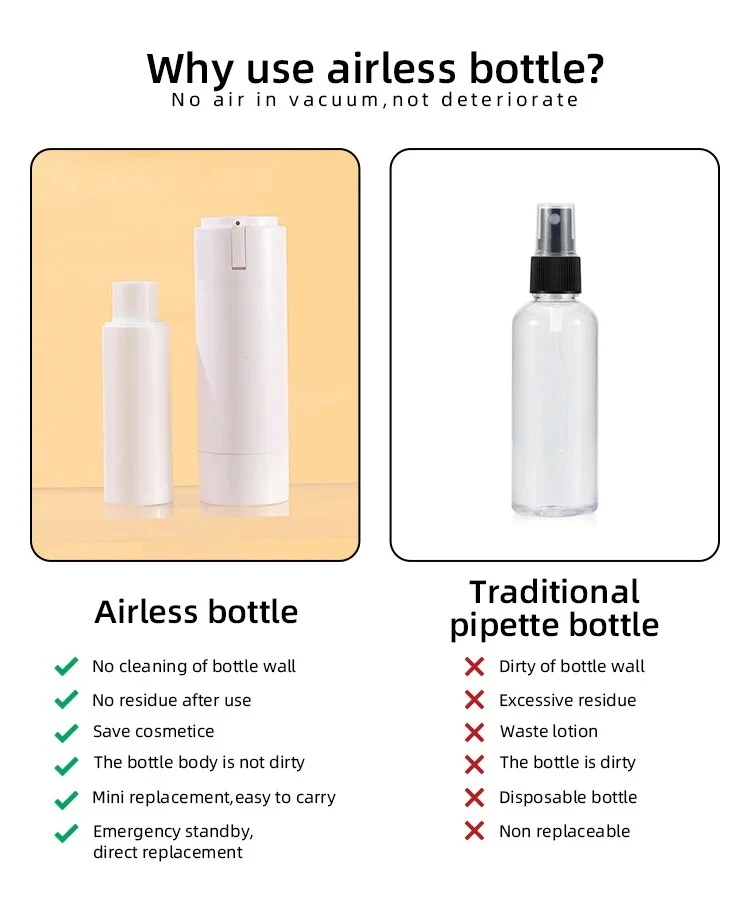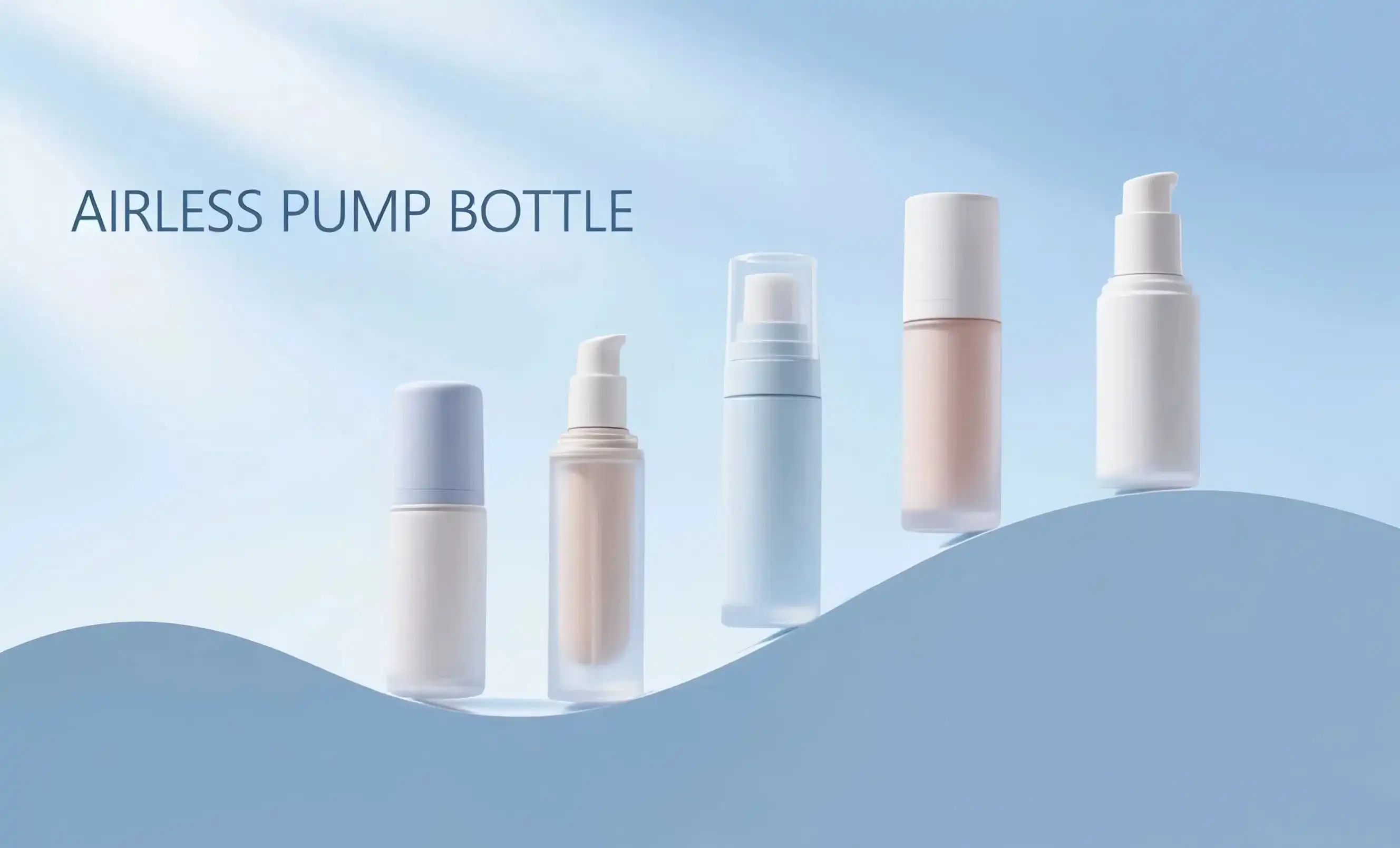For skincare brands, makeup companies, and cosmetics manufacturers, selecting the right packaging is crucial. Airless pump bottles excel in preventing product contamination, reducing waste, and maintaining the efficacy of active ingredients. They are particularly beneficial for natural, organic, and preservative-free formulations. Traditional pumps, while less technologically advanced, can still be suitable for certain products and may offer cost advantages in some scenarios. This article will delve into the key differences between airless and traditional pump bottles, helping you make an informed decision for your brand's packaging needs.
Airless vs. traditional pumps: Which prevents product waste better?
Product waste is a significant concern for both consumers and manufacturers in the beauty industry. The effectiveness of packaging in minimizing waste can have a substantial impact on customer satisfaction and brand reputation. When comparing airless pump bottles to traditional pump bottles, there are several factors to consider in terms of waste prevention.

Dispensing Efficiency
Airless pump systems are designed to dispense nearly 100% of the product contained within the bottle. The vacuum mechanism ensures that even the last drop of product can be accessed and used. This high efficiency is particularly valuable for expensive or luxury skincare products, where every bit counts.
Traditional pump bottles, in contrast, often leave a residual amount of product at the bottom of the container. The dip tube system used in these bottles may not reach the very bottom, resulting in wasted product that customers cannot easily access.
Precision in Dosage
Airless pumps typically offer more precise dosage control compared to traditional pumps. The consistent pressure applied by the vacuum system results in a more uniform amount of product dispensed with each pump. This precision helps users avoid over-dispensing, which can lead to product waste.
Traditional pumps may dispense varying amounts of product depending on how much is left in the bottle and how forcefully the user presses the pump. This inconsistency can sometimes result in users dispensing more product than needed, contributing to waste.
Product Preservation
By preventing air from entering the container, airless pump bottles significantly reduce the risk of product oxidation and contamination. This preservation aspect indirectly prevents waste by maintaining the product's efficacy throughout its use, ensuring that the entire contents remain usable until the end.
Traditional pump bottles, while offering some protection, still allow air to enter the container with each use. This can lead to degradation of sensitive ingredients over time, potentially causing users to discard products before they're fully used if they notice changes in texture, scent, or effectiveness.
How airless technology outperforms standard pumps for sensitive formulas
The protection of sensitive formulas is a critical consideration in the cosmetics and skincare industry. Airless technology offers several advantages over standard pumps when it comes to preserving the integrity and efficacy of delicate ingredients.
Oxygen Barrier
One of the primary benefits of airless pump bottles is their ability to create an effective oxygen barrier. The vacuum system prevents air from entering the container, significantly reducing the oxidation of sensitive ingredients. This is particularly important for formulas containing antioxidants, vitamins, and other active compounds that can degrade when exposed to air.
Standard pumps, on the other hand, allow air to enter the bottle with each use. This repeated exposure to oxygen can gradually diminish the potency of sensitive ingredients, potentially reducing the product's effectiveness over time.
Microbial Protection
Airless systems provide superior protection against microbial contamination. By minimizing air exposure and preventing the backflow of product, these pumps create an environment that is less hospitable to bacteria and other microorganisms. This feature is especially valuable for preservative-free or minimally preserved formulations.
Traditional pump bottles are more susceptible to microbial growth, particularly if water or other contaminants enter the bottle. This can necessitate the use of stronger preservatives, which may not be desirable for brands focusing on natural or sensitive-skin formulations.
Light Protection
Many airless pump bottles are designed with opaque or UV-resistant materials, offering an additional layer of protection for light-sensitive ingredients. This feature helps prevent photodegradation, which can affect the stability and efficacy of certain active compounds.
While some traditional pump bottles may also offer light protection, it's not a standard feature across all designs. This makes airless pumps a more reliable choice for formulations containing light-sensitive ingredients like retinol or vitamin C.
Cost comparison: Are airless pump bottles worth the investment?
When considering packaging options, cost is inevitably a significant factor for brands and manufacturers. While airless pump bottles generally come with a higher upfront cost compared to traditional pump bottles, it's essential to evaluate the long-term value and return on investment they can provide.
Initial Costs vs. Long-Term Savings
The initial investment in airless pump technology is typically higher than that of standard pump bottles. This is due to the more complex mechanism and higher-quality materials used in airless systems. However, the long-term savings can offset this initial cost difference:
- Reduced product waste can lead to more units sold per batch of product manufactured.
- Extended shelf life may result in fewer returns or exchanges due to product degradation.
- Improved user experience and product efficacy can contribute to customer loyalty and repeat purchases.
Impact on Formulation Costs
Airless packaging can potentially reduce formulation costs by:
- Allowing for a reduction in preservatives, which can be expensive and may cause sensitivity in some users.
- Enabling the use of more delicate, natural ingredients that might not be stable in traditional packaging.
- Extending the viability of expensive active ingredients throughout the product's use.
Brand Perception and Marketing Value
While not a direct cost factor, the use of airless technology can enhance brand perception and provide marketing advantages:
- Airless packaging is often associated with premium, high-quality products, which can justify higher price points.
- The eco-friendly aspect of reduced product waste can appeal to environmentally conscious consumers.
- Innovative packaging can differentiate a brand in a competitive market, potentially leading to increased sales and market share.
In conclusion, while airless pump bottles do represent a higher initial investment, their benefits in terms of product protection, waste reduction, and brand perception often make them a worthwhile choice for many skincare and cosmetic brands. The decision ultimately depends on factors such as product type, target market, and brand positioning.
For brands looking to elevate their packaging and product performance, airless pump bottles offer compelling advantages. At Topfeelpack, we specialize in advanced airless packaging solutions that cater to the unique needs of skincare brands, makeup companies, and cosmetics manufacturers. Our commitment to sustainability, fast customization, and competitive pricing makes us an ideal partner for brands seeking to enhance their packaging strategy.
Whether you're a high-end skincare brand, a trendy makeup line, or a DTC beauty company, our team can help you find the perfect airless packaging solution. We understand the importance of quick turnaround times, flexible order quantities, and regulatory compliance in the fast-paced beauty industry. To learn more about how our airless bottles can benefit your brand and to discuss your specific packaging needs, please contact us at pack@topfeelgroup.com. Let's work together to create packaging that protects your formulas, impresses your customers, and elevates your brand.
References
- Journal of Cosmetic Science: "Airless Packaging Systems: Effect on Product Stability and Consumer Perception"
- Packaging Technology and Science: "Comparative Study of Airless and Traditional Pump Dispensers in Cosmetic Applications"
- International Journal of Cosmetic Science: "Preservation Efficacy in Airless vs. Traditional Packaging Systems"
- Cosmetics & Toiletries Magazine: "The Evolution of Airless Packaging in the Beauty Industry"
- Sustainability in Cosmetic Packaging: A Comprehensive Review
- Beauty Packaging Magazine: "Cost-Benefit Analysis of Advanced Packaging Technologies in Cosmetics"
This article is reposted from “Airless Pump vs Traditional Pump Bottles: Which Should You Choose”.
Original link: https://www.ecoairlessbottles.com/news/benefits-of-airless-beauty-bottles/
If there is any infringement, please contact us for removal.

 - 副本_1745399213966.webp)

_1747827716538.webp)

